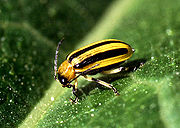
Cucumber beetle
Encyclopedia


Cucumber beetle is a common name given to members of two genera of beetles, Diabrotica
Diabrotica
Diabrotica is a widespread genus of beetles, sometimes referred to as cucumber beetles or corn rootworms, in the family Chrysomelidae. Members of this genus include several destructive agricultural pest species.-Range:...
and Acalymma
Acalymma
Acalymma is a genus of leaf beetles found mainly in the New World. Approximately 72 species have been described in the Western Hemisphere.-Pest Species and Impacts:...
, both in the family Chrysomelidae. The name stems from the tendency for adults of these beetles to be found on the leaves and flowers of cucurbits
Cucurbitaceae
The plant family Cucurbitaceae consists of various squashes, melons, and gourds, including crops such as cucumber, pumpkins, luffas, and watermelons...
; which are plant species of the melon, cucumber and squash varieties.
The two most common pests in this family are the striped cucumber beetle and spotted cucumber beetle, which looks very much like a green ladybug. However, unlike the ladybug, cucumber beetles are not considered beneficial insects. They are sucking invaders which harm crops and ornamental plants.
At two stages of their approx. 8 week lifespan, these insects cause damage to plants. Adults will attack the tender young growth of stems and leaves, and the buds and petals on mature specimens. They also carry and spread the bacterial wilt organism
Bacterial wilt
Bacterial wilt is a cucurbit disease caused by the pathogen Erwinia tracheiphila, a Gram-negative bacterium in the family Enterobacteriaceae. Cucumber and muskmelon plants are most susceptible, but squash, pumpkins, and gourds may also become infected. Watermelons are immune to the disease.-...
, Erwinia tracheiphila and the cucumber mosaic virus
Cucumber mosaic virus
Cucumber mosaic virus is a plant pathogenic virus in the family Bromoviridae.It is the type member of the plant virus genus, Cucumovirus. This virus has a worldwide distribution and a very wide host range. In fact it has the reputation of having the widest host range of any known plant virus...
. Eggs are laid in clusters on the underside of host leaves, and hatch into yellowish larvae (coloration varies) approx 1/2 in long. The larvae then commence to feed on plant roots by tunneling into the ground. In some areas, the larvae is called the "corn rootworm".
Cucumber beetles can attack and overwinter in corn and bean fields; in some areas they may hide out in compost or trash piles. Eradication consists of manual removal, keeping cultivated areas free of litter and debris from infested plants, and application of pyrethrin
Pyrethrin
The pyrethrins are a pair of natural organic compounds that have potent insecticidal activity. Pyrethrins are neurotoxins that attack the nervous systems of all insects. When present in amounts not fatal to insects, they still appear to have an insect repellent effect. Pyrethrins are gradually...
-containing insecticides applied directly to host plants, such as Cyfluthrin or a non-systemic organphosphate insectside like malathion. Caution and strict adherence to safety instructions and directions-for-use are advised when using insecticides, especially on plants bearing produce for human or animal consumption.
External links
- Cucumber Beetles Virginia Cooperative Extension Office
- Vegetable Diseases - Cass County Extension Office

